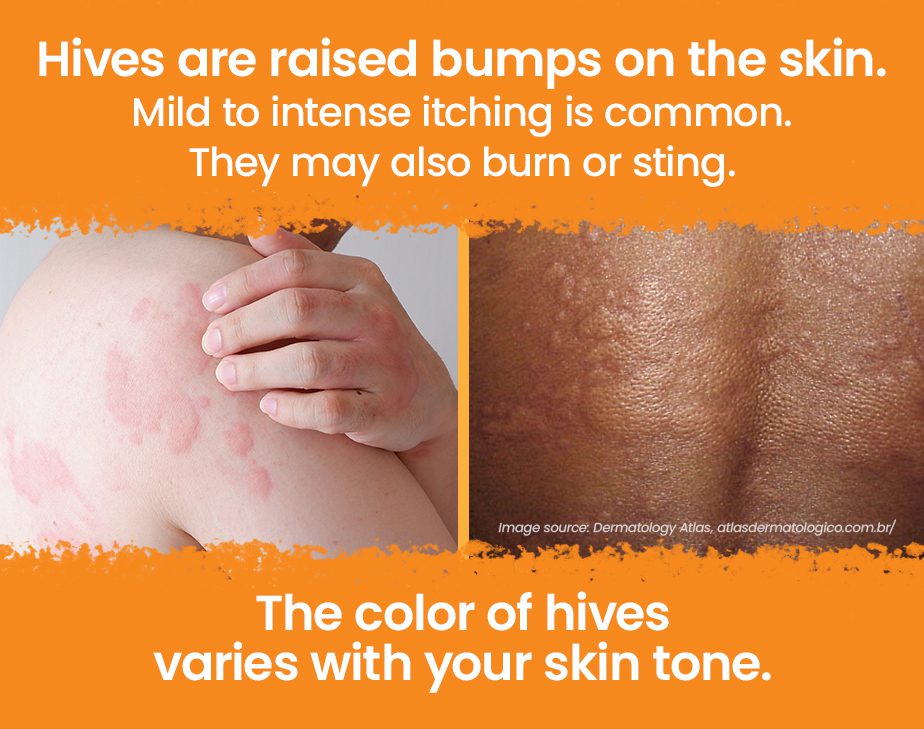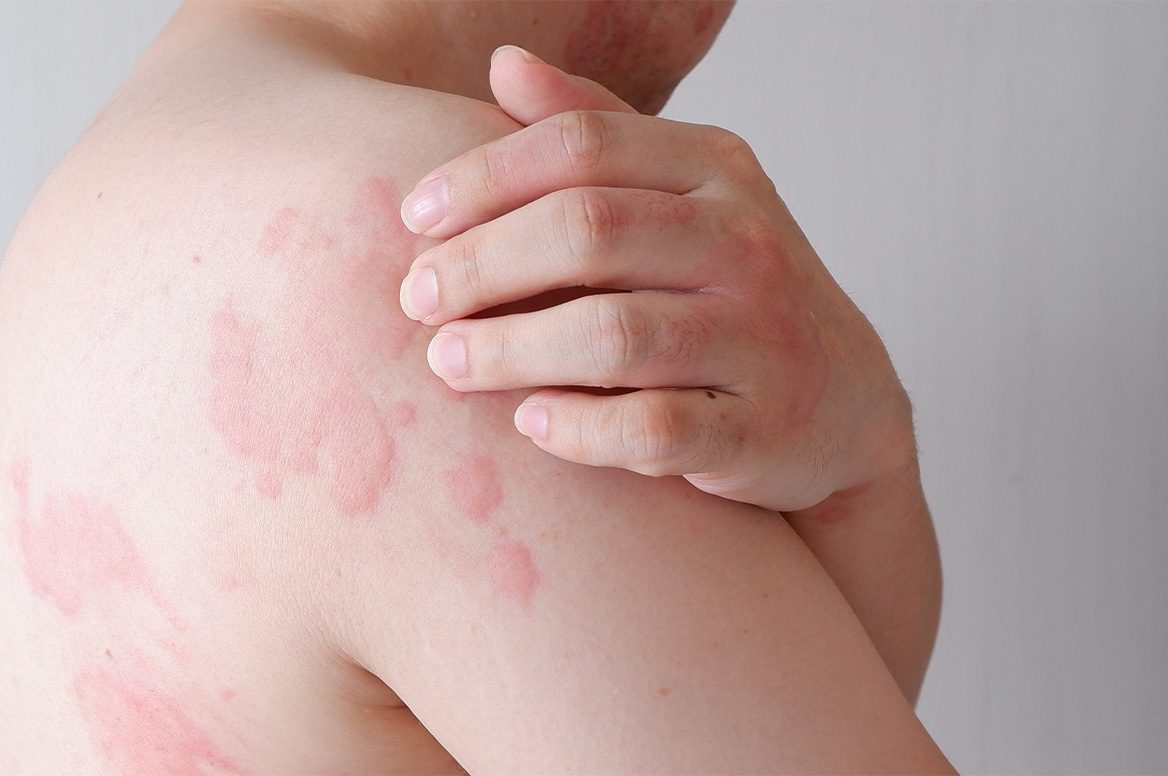Allergies
Hives (Urticaria)
The medical name for hives is urticaria. Hives are a common sign of an acute allergic reaction. Hives can also occur due to other causes, including a viral or bacterial infection. Hives may also develop due to no known cause or spontaneously. It is estimated that hives affect about 20% of people at some point during their lives.1
What Are Hives (Urticaria)?
Hives are a type of swelling of the skin and are common symptoms of an allergic reaction. Hives can occur alone as the single symptom of an allergy reaction, or you may develop hives with other allergy symptoms. Hives can occur during severe allergic reactions known as anaphylaxis [anna-fih-LACK-sis].1
Hives can also happen unrelated to allergic reactions. They can be triggered by skin irritation, infections, medical conditions, or have no known cause.
It is estimated that hives affect about 1 out of 5 people at some point during their lives.1
What Do Hives Look Like?
Hives are raised bumps, called welts or wheals, on the skin. They can resemble bug bites. Hives can be small or large and can occur anywhere on the body. Hives may change shape and move around different areas of your body. They usually appear and disappear suddenly and may reappear over short periods of time. The center of the hive will become white when pressed (blanching). The welts from hives may join together, forming larger areas (plaques).1,2
The color of hives varies with your skin tone. People with light or medium skin usually have red or pink hives. People with brown or black skin usually have hives of the same color as their skin, or slightly darker or lighter than their natural skin tone.3
Mild to intense itching is a common symptom of hives. Other symptoms include burning and stinging.1,2
Call your doctor if:
- Your hives are making you uncomfortable
- You have never experienced hives before
Go to the emergency room or call 911 if:
- Your hives are severe and cover a large area of your body
- You have other symptoms such as trouble breathing

What Are the Different Types of Hives?
Acute hives often occur as an allergic reaction to an allergen (substance that causes an allergic immune reaction), and usually last a few hours to a few days or less than 6 weeks. Acute hives form because of the release of histamine by the mast cells (immune cells) in your skin, in response to the presence of allergens.1 It is common for acute hives to occur as part of a viral infection. There are a few other sources of inflammation in the body that can lead to short-term hives lasting a few days to even a few weeks.
Contact hives are a form of acute urticaria. The hives occur at the site of contact with the allergen or irritating substance, up to 1 hour after the exposure. Contact hives usually resolve within a day.4
Chronic hives (chronic urticaria) occur almost daily and by definition last for more than 6 weeks. Chronic hives may be caused by infections, a problem with the immune system, or as result of other medical conditions such as lupus or other autoimmune conditions. Chronic hives are rarely caused by allergies to a food or environmental trigger. Allergists generally do not recommend allergy testing for chronic hives. However, it is most common that chronic hives have no known cause and just happen for unknown reasons. Thus, chronic hives are their own thing.
When you have chronic hives for an unknown reason, your doctor may diagnose you with chronic spontaneous urticaria (CSU), previously called chronic idiopathic urticaria (CIU).
Chronic hives may also be triggered by known physical factors, being called chronic inducible urticaria (CIndU). Triggers for CIndU include cold, heat, pressure, vibrations, exercising, sweating, and UV light from sun exposure (very rare).1,2,5
What Triggers Hives?
Several factors, medical conditions, and allergens that can trigger hives are identified. These include:2,4
- Food allergies
- Pet dander
- Airborne allergens, such as pollen
- Medications, such as antibiotics (especially penicillin and sulfa) or non-steroidal painkillers (aspirin and ibuprofen)
- Dyes in medications
- Insect stings or bites
- Physical stimuli such as pressure, cold, heat, vibrations, exercise, or sun exposure
- Latex
- Metals
- Fragrances and flavorings
- Detergents and disinfectants
- Blood transfusions
- Bacterial infections, including urinary tract infections and strep throat
- Viral infections, including the common cold, infectious mononucleosis, and hepatitis
- Some plants, such as poison ivy, oak, and sumac
- Medical conditions, especially autoimmune conditions such as lupus
Despite all the known potential triggers, sometimes urticaria may develop due to unknown causes.5
How Do Doctors Diagnose Hives?
Your doctor will look at your skin and will ask you about your recent medical history.
For acute hives, the doctor may do allergy testing, including skin tests and blood tests. Allergy testing can be used to identify the allergens that may be triggering the reaction.1
What Are the Recommended Treatments for Hives?
Many cases of hives are harmless and go away on their own. This is typical of an untreated allergic reaction, so long as there is no further exposure to the trigger. Applying cold compresses, taking cool showers, or wearing loose-fitting clothing may also help to reduce the symptoms.1
Acute hives treatment
For cases of acute hives, antihistamines are the preferred immediate treatment. A topical corticosteroid [kor-tick-OH-stair-ROID] may help the hives go away faster. Using topical creams is not a preferred strategy for hives that are recurring, even in the short term.
Systemic (oral) corticosteroids such as prednisone may be prescribed to relieve hive symptoms when antihistamines or topical steroids are not effective. But there are limits to their recommended use:
- These types of steroids have a risk of serious side effects
- The course of steroids needs to be carefully tapered off
- There is potential for rebound worsening of hives
For hives lasting a few days, systemic corticosteroids may work quite well, but this is also not a preferred long-term strategy except in very rare cases.
If hives occur as part of a serious allergic reaction (known as anaphylaxis), the allergic reaction should be treated immediately with epinephrine, and antihistamine can be given after epinephrine is given.1
Chronic hives treatment
The first strategy to treat chronic hives is with over-the-counter or prescription antihistamines, first at standard (e.g., what the box says) doses, which can increase to generally double the dose for lack of relief.
Desloratadine (Clarinex) and hydroxyzine (Vistaril) are prescription antihistamines used to treat hives. Over-the-counter antihistamine options include cetirizine (Zyrtec), loratadine (Claritin), and fexofenadine (Allegra).
If after 6 weeks the antihistamines are not working, other treatments may be recommended:
Your doctor may recommend a biologic treatment to treat your chronic hives:
- Omalizumab (XOLAIR®), a medicine approved by the Food and Drug Administration (FDA) for the treatment of CSU in people aged 12 years and older. XOLAIR works by attaching itself to the IgE antibodies to help prevent your body from overreacting and producing hives. It is an anti-IgE medicine.6
- Dupilumab (DUPIXENT®), a medicine approved by FDA for the treatment of CSU in people aged 12 years and older. DUPIXENT works by inhibiting proteins responsible for inflammatory signals in your body, controlling the inflammation that leads to hives.7
Another option is a treatment that blocks a specific enzyme (protein) involved in hives:
- Remibrutnib (Rhapsido®), an oral medicine approved by the FDA for the treatment of CSU in adults. It works by blocking the release of histamine and other inflammation mediators that cause hives.8
Systemic (oral) corticosteroids and cyclosporine may be used. Both are linked to significant side effects. Cyclosporine is a medicine that reduces the activity of the immune system and prevents new hives.9
A less common treatment is phototherapy (light therapy) which exposes the skin to a controlled amount of light. This treatment is typically paired with antihistamines.
A recent study (called a network meta-analysis) compared all the different types of chronic urticaria treatments against one another.10 It reviewed treatments from the past, presently available, and those that are under development. The results suggested that these options worked best for urticaria flares, improving quality of life, and had strong safety data in terms of side effects:10
- Omalizumab (XOLAIR)
- Remibrutinib (Rhapsido)
- Dupilumab (DUPIXENT)
It’s important to talk with your dermatologist, allergist, or primary care doctor about the benefits and risks of treatment options. There are many ways to try to treat chronic urticaria, most of which depend on what you as the patient may want or prefer.
How Can I Prevent Hives?
Since acute hives can be caused by an allergic reaction, the best way to prevent them is to avoid being exposed to allergens you are allergic to. The results of allergy tests will help you know which allergens trigger your hives. If you are allergic to animals, plants, or pollen, take a bath, and change your clothes after you have contact with one of these allergens.1,11
Preventing chronic hives is difficult. Chronic hives are not usually triggered by allergens, and their cause is often unknown.1
Are Hives Contagious?
Hives are not contagious. However, when you develop hives after being exposed to allergens such as secretions from poison ivy, you can spread the allergen if you don’t wash it off your skin.1
Med Communications, Inc. assisted with development and review of medical content. Medical review: September 2025 by Alison Ehrlich, MD, MHS and Matthew Greenhawt, MD, MBA, MSc
Acknowledgements
This content is developed independently by the Asthma and Allergy Foundation of America (AAFA) and made possible by contributions from Novartis, Sanofi and Regeneron.
Closed
References
- Cleveland Clinic. (2022, October 14). Hives. My Cleveland Clinic. Retrieved September 18, 2025, from: https://my.clevelandclinic.org/health/diseases/8630-hives
- American College of Allergy, Asthma and Immunology. (2018, July 11). Hives. Retrieved September 19, 2025, from: https://acaai.org/allergies/allergic-conditions/skin-allergy/hives/
- American Academy of Dermatology. (2024, May 30). Hives: Signs and Symptoms. Retrieved September 19, 2025, from: https://www.aad.org/public/diseases/a-z/hives-symptoms
- Vethachalam S, & Persaud Y. (2023, July 31). Contact Urticaria. In StatPearls. StatPearls Publishing. Retrieved September 18, 2025, from: https://www.ncbi.nlm.nih.gov/books/NBK549890/
- Dabija D, Tadi P, & Danosos GN. (2023, April 17). Chronic Urticaria. In StatPearls. StatPearls Publishing. Retrieved September 18, 2025, from: https://www.ncbi.nlm.nih.gov/books/NBK555910/
- Genentech, Inc. (2024). XOLAIR Prescribing Information. http://www.gene.com/download/pdf/xolair_prescribing.pdf
- Regeneron. (2025). DUPIXENT® Prescribing Information. https://www.regeneron.com/downloads/dupixent_fpi.pdf
- Novartis. (2025). Rhapsido® Prescribing Information. https://www.novartis.com/us-en/sites/novartis_us/files/rhapsido.pdf
- American Academy of Dermatology. (2025, May 22). Hives: Diagnosis and Treatment. Retrieved September 19, 2025, from: https://www.aad.org/public/diseases/a-z/hives-treatment
- Chu, A. W. L., Oykhman, P., Chu, X., Rayner, D. G., Bhangal, S., Dam, A., Xu, J., Sheikh, J., Trayes, K. P., Frazier, W. T., Lang, D. M., Beck, L. A., Mathur, S. K., Waserman, S., Thabane, L., Asiniwasis, R. N., Runyon, L., Moellman, J., Oliver, E. T., Chan, J., … Chu, D. K. (2022). Comparative efficacy and safety of biologics and systemic immunomodulatory treatments for chronic urticaria: Systematic review and network meta-analysis. Journal of Allergy and Clinical Immunology. Advance online publication. https://doi.org/10.1016/j.jaci.2025.06.004
- Mayo Clinic. (2023, October 27). Hives and angioedema. Retrieved September 19, 2025, from: https://www.mayoclinic.org/diseases-conditions/hives-and-angioedema/symptoms-causes/syc-20354908













